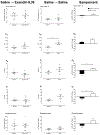Contribution of endogenous glucagon-like peptide-1 to changes in glucose metabolism and islet function in people with type 2 diabetes four weeks after Roux-en-Y gastric bypass (RYGB)
- PMID: 30586575
- PMCID: PMC6401231
- DOI: 10.1016/j.metabol.2018.12.005
Contribution of endogenous glucagon-like peptide-1 to changes in glucose metabolism and islet function in people with type 2 diabetes four weeks after Roux-en-Y gastric bypass (RYGB)
Abstract
Glucagon-Like Peptide-1 (GLP-1) is an insulin secretagogue which is elevated after Roux-en-Y Gastric Bypass (RYGB). However, its contribution to glucose metabolism after RYGB remains uncertain.
Aims: We tested the hypothesis that GLP-1 lowers postprandial glucose concentrations and improves β-cell function after RYGB.
Materials and methods: To address these questions we used a labeled mixed meal to assess glucose metabolism and islet function in 12 obese subjects with type 2 diabetes studied before and four weeks after RYGB. During the post-RYGB study subjects were randomly assigned to receive an infusion of either saline or Exendin-9,39 a competitive antagonist of GLP-1 at its receptor. Exendin-9,39 was infused at 300 pmol/kg/min for 6 h. All subjects underwent RYGB for medically-complicated obesity.
Results: Exendin-9,39 resulted in increased integrated incremental postprandial glucose concentrations (181 ± 154 vs. 582 ± 129 mmol per 6 h, p = 0.02). In contrast, this was unchanged in the presence of saline (275 ± 88 vs. 315 ± 66 mmol per 6 h, p = 0.56) after RYGB. Exendin-9,39 also impaired β-cell responsivity to glucose but did not alter Disposition Index (DI).
Conclusions: These data indicate that the elevated GLP-1 concentrations that occur early after RYGB improve postprandial glucose tolerance by enhancing postprandial insulin secretion.
Copyright © 2018 Elsevier Inc. All rights reserved.
Conflict of interest statement
Figures





Similar articles
-
Roux-en-Y gastric bypass compared with equivalent diet restriction: Mechanistic insights into diabetes remission.Diabetes Obes Metab. 2018 Jul;20(7):1710-1721. doi: 10.1111/dom.13287. Epub 2018 Apr 10. Diabetes Obes Metab. 2018. PMID: 29532631 Free PMC article.
-
Effects of endogenous GLP-1 and GIP on glucose tolerance after Roux-en-Y gastric bypass surgery.Am J Physiol Endocrinol Metab. 2016 Apr 1;310(7):E505-14. doi: 10.1152/ajpendo.00471.2015. Epub 2016 Jan 19. Am J Physiol Endocrinol Metab. 2016. PMID: 26786780 Clinical Trial.
-
Contribution of endogenous glucagon-like peptide 1 to glucose metabolism after Roux-en-Y gastric bypass.Diabetes. 2014 Feb;63(2):483-93. doi: 10.2337/db13-0954. Epub 2013 Oct 2. Diabetes. 2014. PMID: 24089513 Free PMC article.
-
Mechanisms of improved glycaemic control after Roux-en-Y gastric bypass.Dan Med J. 2015 Apr;62(4):B5057. Dan Med J. 2015. PMID: 25872541 Review.
-
Current evidence for a role of GLP-1 in Roux-en-Y gastric bypass-induced remission of type 2 diabetes.Diabetes Obes Metab. 2012 Apr;14(4):291-8. doi: 10.1111/j.1463-1326.2011.01505.x. Epub 2011 Nov 13. Diabetes Obes Metab. 2012. PMID: 21951387 Review.
Cited by
-
Glucagon-like peptide-1 effect on β-cell function varies according to diabetes remission status after Roux-en-Y gastric bypass.Diabetes Obes Metab. 2022 Nov;24(11):2081-2089. doi: 10.1111/dom.14793. Epub 2022 Jun 28. Diabetes Obes Metab. 2022. PMID: 35676799 Free PMC article.
-
Role and mechanism of Roux-en-Y gastric bypass in the treatment of diabetic urinary bladder hyperactivity by reducing TRPV1 and P2X3.World J Diabetes. 2025 Apr 15;16(4):96176. doi: 10.4239/wjd.v16.i4.96176. World J Diabetes. 2025. PMID: 40236849 Free PMC article.
-
Minimal and Maximal Models to Quantitate Glucose Metabolism: Tools to Measure, to Simulate and to Run in Silico Clinical Trials.J Diabetes Sci Technol. 2022 Sep;16(5):1270-1298. doi: 10.1177/19322968211015268. Epub 2021 May 25. J Diabetes Sci Technol. 2022. PMID: 34032128 Free PMC article.
-
Potential contribution of the gut microbiota to hypoglycemia after gastric bypass surgery.Chin Med J (Engl). 2020 Aug 5;133(15):1834-1843. doi: 10.1097/CM9.0000000000000932. Chin Med J (Engl). 2020. PMID: 32649508 Free PMC article. Review.
-
Increased Risk of Hypoglycemia Following Roux-en-Y Gastric Bypass Surgery in Patients Without Diabetes: a Propensity Score-Matched Analysis.Obes Surg. 2024 Dec;34(12):4385-4392. doi: 10.1007/s11695-024-07565-y. Epub 2024 Nov 13. Obes Surg. 2024. PMID: 39532813 Free PMC article.
References
-
- Buchwald H, Avidor Y, Braunwald E, Jensen MD, Pories W, Fahrbach K, et al. Bariatric surgery: a systematic review and meta-analysis. Jama. 2004;292:1724–37. - PubMed
-
- Kashyap SR, Bhatt DL, Wolski K, Watanabe RM, Abdul-Ghani M, Abood B, et al. Metabolic Effects of Bariatric Surgery in Patients With Moderate Obesity and Type 2 Diabetes: Analysis of a randomized control trial comparing surgery with intensive medical treatment. Diabetes Care. 2013;36:2175–82. - PMC - PubMed
Publication types
MeSH terms
Substances
Grants and funding
LinkOut - more resources
Full Text Sources
Other Literature Sources
Medical
Research Materials

